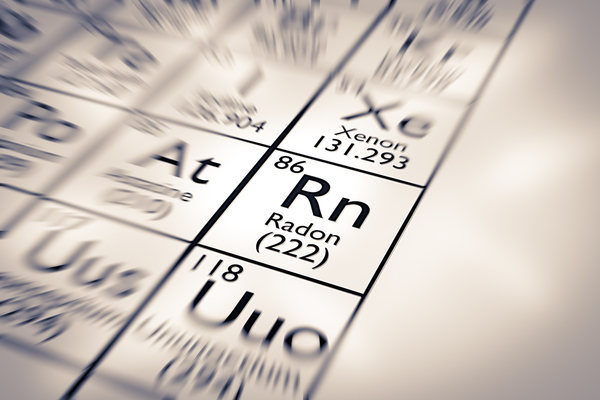Both at work and at home, this colourless gas is making people sick

The Government of Canada predicts more than one in 10 Canadians are at risk of over-exposure to radon. As occupational health and safety professionals, we need to get a handle on the issue, communicate effectively with stakeholders about the risk and build a strategy to control radon exposure at work and at home.
Radon is a colourless, odourless, radioactive gas found naturally in the environment. It is produced by the breakdown of uranium found in soil, rock or water. Radon is an invisible form of ionizing radiation. When radon is released from the ground into the outdoor air, it is quickly diluted and is not a concern. When radon seeps through cracks in foundations and walls of buildings, or through the gaps around pipe penetrations and enters enclosed spaces, it can accumulate to high levels and become a risk.
Radon was first recognized as a health hazard in homes in the mid-1980s. According to Health Canada, being exposed to high levels of radon in indoor air results in an increased risk of developing lung cancer. In 2014, the agency estimated that radon exposures caused 3,000 deaths per year from lung cancer.
Radon is the number 1 cause of lung cancer in non-smokers. The risk of cancer depends on the level of radon and how long a person is exposed to those levels. Exposure to both radon and tobacco smoke synergize to create an even higher risk of lung cancer.
Although there is currently no regulation for an acceptable level of radon in Canadian homes or workplaces, Health Canada has developed a guideline stating levels should not exceed 200 Bq/m3 (becquerels per cubic metre of air). It is estimated about seven per cent of houses in Canada have radon levels above this limit. However, this is still twice the level recommended by the World Health Organization.
Only testing can tell you if you have a problem. The Government of Canada has developed a guide for residential testing for radon in homes. Testing is relatively simple, inexpensive and typically completed over a three-month period. Testing is best completed in the lower levels of the building. There are two choices when it comes to testing. You can purchase a “do-it-yourself” radon test kit or you can hire a professional consultant to undertake the assessment. If you choose to purchase a radon test kit, you will need to carefully follow the instructions on how to set up the test and ship the test equipment to the laboratory for analysis. If you choose to hire a consultant to undertake an assessment, it is recommended that you ensure they are a Registered Occupational Hygienist (ROH), Certified Industrial Hygienist (CIH) or are otherwise certified to do this type of work. A program of testing will reveal the exposure levels and the associated health risk.
The results of testing in Canada have been very telling. For example, in the first year of a testing program undertaken by the Yukon government, 164 buildings across the territory were tested, including 24-hour residential care facilities, detention centres, schools, health centres and staff housing. They found 21 buildings with radon levels above Health Canada’s guidelines for public buildings.
If the results of the radon testing are above the 200 Bq/m3 guideline, the fix can be quite simple. You should hire a consultant to determine the best and most cost-effective way to reduce the radon levels in your home. Health Canada recommends that the consultant be certified as a radon mitigation professional from the Canadian National Radon Proficiency Program (C-NRPP). Techniques to lower radon levels are effective and can save lives. A radon mitigation system can be installed simply in most buildings that will reduce the radon levels by more than 80 per cent. Fixing cracks and other types of remediation that will drastically cut the level of radon in a home will cost a few thousand dollars. Simply increasing ventilation rates can dramatically improve the air quality.
The most common radon reduction method is called sub-slab depressurization, which is installed through the basement flooring. A fan is used to draw air from below the slab and exhaust through an outside wall or up through to the roof line. The fan maintains a slight negative pressure sub-slab, reducing migration of radon through the slab into the building. In conjunction with sub-slab depressurization, increasing general ventilation and sealing major entry routes can also help reduce radon levels.
If you want to learn more about radon risks and remediation, there are lots of resources available. The C-NRPP offers a certification program for professionals that establishes guidelines, training and resources. The courses include a range of online and in-class sessions, providing general awareness-level information on radon — right up to allowing a participant to qualify as a radon measurement professional or a radon mitigation professional.
Since the 1980s we have learned a great deal more about the health risks of exposure to radon. There is a lot we can do to reduce the risk. For starters, we can start talking about the issue. We can also plan to get some testing completed so we know where our remediation dollars can be best spent. If you don’t have an in-house expert, hire one to help you. If the science of ionizing radiation isn’t your specialty or if you don’t have to time to seek certification as a radon measurement or a radon mitigation specialist, enlist the help of an ROH, CIH or other certified professionals to help you. We need tune in and take action. The trend of fatalities due to radon needs to be abated. The safety community needs to take a role to communicate this issue and get everyone moving in the right direction.
This article originally appeared in the February/March 2019 issue of COS.






